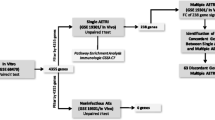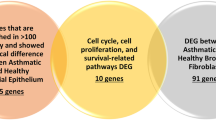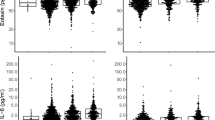Abstract
Background
Gene expression can provide distinct information compared to clinical biomarkers in the context of longitudinal clinical outcomes in asthma patients.
Objective
This study examined the association between the gene expression levels of upstream (IL-25, IL-33, and TSLP) and downstream cytokines (IL-5, IL-4, and IL-13) in the T2 inflammatory pathway with a 12-month follow-up of exacerbation, lung function, and steroid use.
Methods
Transcriptomic sequencing analysis was performed on peripheral blood mononuclear cells from 279 adult asthmatics. Survival analysis and linear mixed-effect models were used to investigate potential differences between the high-level and low-level gene expression groups and the clinical outcomes. Analysis was performed separately for the upstream, downstream, and all 6 cytokines.
Results
In general, T2 inflammatory cytokine gene expression showed a weak correlation with blood eosinophil counts (all r < 0.1) and clinical outcomes. Among moderate-to-severe eosinophilic asthma (MSEA) patients, individuals with elevated levels of downstream cytokines were at increased risk of time-to-first exacerbation (p = 0.044) and a greater increase of inhaled corticosteroid use over time (p = 0.002) compared to those with lower gene expression. There was no association between baseline T2 inflammatory cytokine gene expression and the longitudinal changes in lung function over time among MSEA patients.
Conclusion
These findings suggest that, among MSEA patients, the gene expression levels of downstream cytokines in the T2 inflammatory pathway may serve as indicators for endoty** asthma.




Similar content being viewed by others
Abbreviations
- ACT:
-
Asthma control test
- BEC:
-
Blood eosinophil count
- Bude_eq:
-
Budesonide equivalent dose
- COREA:
-
Cohort for Reality and Evolution of Adult Asthma in Korea
- FeNO:
-
Fractional exhaled nitric oxide
- FEV:
-
Forced expiratory volume in the first second
- ICS:
-
Inhaled corticosteroids
- IL:
-
Interleukin
- MSEA:
-
Moderate-to-severe eosinophilic asthma
- OCS:
-
Oral systemic steroids
- PBMC:
-
Peripheral blood mononuclear cells
- Pred_eq:
-
Prednisolone equivalent dose
- TSLP:
-
Thymic stromal lymphopoietin
References
Kuruvilla ME, Lee FE, Lee GB (2019) Understanding asthma phenotypes, endotypes, and mechanisms of disease. Clin Rev Allergy Immunol 56(2):219–233
Hammad H, Lambrecht BN (2021) The basic immunology of asthma. Cell 184(9):2521–2522
Coverstone AM, Seibold MA, Peters MC (2020) Diagnosis and management of T2-high asthma. J Allergy Clin Immunol Pract 8(2):442–450
Busse WW, Viswanathan R (2022) What has been learned by cytokine targeting of asthma? J Allergy Clin Immunol 150(2):235–249
Lambrecht BN, Hammad H, Fahy JV (2019) The cytokines of asthma. Immunity 50(4):975–991
Dimitrova D, Youroukova V, Ivanova-Todorova E, Tumangelova-Yuzeir K, Velikova T (2019) Serum levels of IL-5, IL-6, IL-8, IL-13 and IL-17A in pre-defined groups of adult patients with moderate and severe bronchial asthma. Respir Med 154:144–154
Joseph J, Benedict S, Safa W, Joseph M (2004) Serum interleukin-5 levels are elevated in mild and moderate persistent asthma irrespective of regular inhaled glucocorticoid therapy. BMC Pulm Med 4:2
Kuo CS, Pavlidis S, Loza M, Baribaud F, Rowe A, Pandis I et al (2017) T-helper cell type 2 (Th2) and non-Th2 molecular phenotypes of asthma using sputum transcriptomics in U-BIOPRED. Eur Respir J 49(2):1602135
Lee HW, Baek MG, Choi S, Ahn YH, Bang JY, Sohn KH et al (2022) Peripheral blood transcriptomic clusters uncovered immune phenotypes of asthma. Respir Res 23(1):237
Peters MC, Mekonnen ZK, Yuan SP, Bhakta NR, Woodruff PG, Fahy JV (2014) Measures of gene expression in sputum cells can identify T2-high and T2-low subtypes of asthma. J Allergy Clin Immun 133(2):388-U181
Kuo CS, Pavlidis S, Loza M, Baribaud F, Rowe A, Pandis I et al (2017) A Transcriptome-driven analysis of epithelial brushings and bronchial biopsies to define asthma phenotypes in U-BIOPRED. Am J Respir Crit Care Med 195(4):443–455
Peters MC, Ringel L, Dyjack N, Herrin R, Woodruff PG, Rios C et al (2019) A transcriptomic method to determine airway immune dysfunction in T2-High and T2-Low Asthma. Am J Resp Crit Care 199(4):465–477
Liew CC, Ma J, Tang HC, Zheng R, Dempsey AA (2006) The peripheral blood transcriptome dynamically reflects system wide biology: a potential diagnostic tool. J Lab Clin Med 147(3):126–132
Kim TB, Park CS, Bae YJ, Cho YS, Moon HB, Group CS. Factors associated with severity and exacerbation of asthma: a baseline analysis of the cohort for reality and evolution of adult asthma in Korea (COREA). Ann Allergy Asthma Immunol 2009; 103 (4): 311-317
Wan Y, Qu K, Ouyang Z, Chang HY (2013) Genome-wide map** of RNA structure using nuclease digestion and high-throughput sequencing. Nat Protoc 8(5):849–869
Global initiative for asthma. global strategy for asthma management and prevention. 2022. https://ginasthma.org/wp-content/uploads/2022/07/GINA-Main-Report-2022-FINAL-22-07-01-WMS.pdf. Date last accessed: June 2023
Gauvreau GM, O’Byrne PM, Boulet LP, Wang Y, Cockcroft D, Bigler J et al (2014) Effects of an anti-TSLP antibody on allergen-induced asthmatic responses. N Engl J Med 370(22):2102–2110
Menzies-Gow A, Corren J, Bourdin A, Chupp G, Israel E, Wechsler ME et al (2021) Tezepelumab in adults and adolescents with severe. Uncontrolled Asthma N Engl J Med 384(19):1800–1809
Theofani E, Tsitsopoulou A, Morianos I, Semitekolou M (2023) Severe asthmatic responses: the impact of TSLP. Int J Mol Sci 24(8):7581
Skrgat S, Malovrh MM, Sarc I, Silar M, Dimitric V, Korosec P. TSLP as biomarker in asthma patients. European Respiratory Journal 2015; 46.
Svenningsen S, Nair P (2022) Persistent airway plugs: a call for clinical recognition and novel therapies. Am J Resp Crit Care 205(9):977–978
Funding
This research was supported by the Bio & Medical Technology Development Program of the National Research Foundation (NRF) funded by the Korean government (MSIT) (2019M3E5D3073365).
Author information
Authors and Affiliations
Contributions
TBK designed the study, applied for the project, and supervised the whole process. DDP analyzed the data and drafted the manuscript. ES and JEL collected the gene expression data, while JHL, WJS, HSK, and YSK collected clinical data. SHW designed and supervised the analysis of the gene expression data
Corresponding author
Ethics declarations
Competing interests
The authors declare no competing interests.
Additional information
Publisher's Note
Springer Nature remains neutral with regard to jurisdictional claims in published maps and institutional affiliations.
Supplementary Information
Below is the link to the electronic supplementary material.
Rights and permissions
Springer Nature or its licensor (e.g. a society or other partner) holds exclusive rights to this article under a publishing agreement with the author(s) or other rightsholder(s); author self-archiving of the accepted manuscript version of this article is solely governed by the terms of such publishing agreement and applicable law.
About this article
Cite this article
Pham, D.D., Shin, E., Lee, J.E. et al. Transcriptomic Expression of T2-Inflammation Genes in Peripheral Blood Mononuclear Cells and Longitudinal Clinical Outcomes in Asthma: Insights from the COREA Study. Lung (2024). https://doi.org/10.1007/s00408-024-00728-9
Received:
Accepted:
Published:
DOI: https://doi.org/10.1007/s00408-024-00728-9




